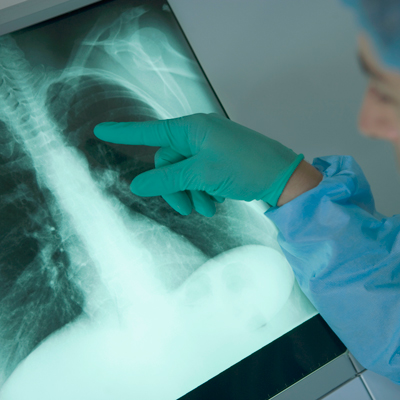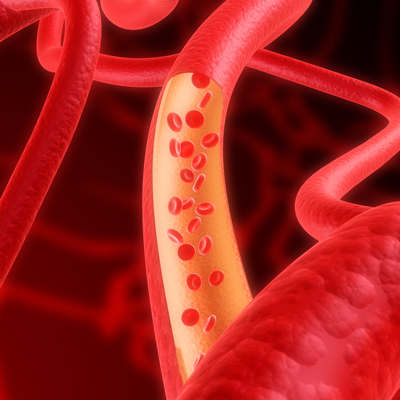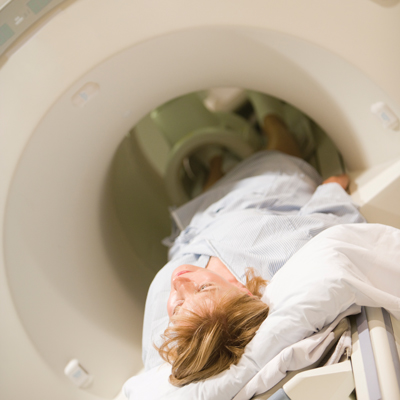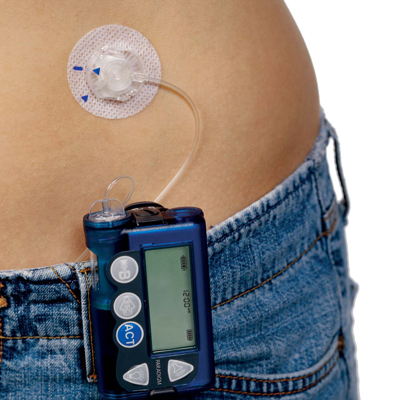Overview

What is pulmonary hypertension?
Pulmonary hypertension is a rare lung disorder affecting your pulmonary arteries, which are the arteries that carry blood from your heart to your lungs to pick up oxygen. In patients with pulmonary hypertension, these arteries are narrowed, making it harder for blood to flow through the vessels and resulting in abnormally high pressure. This high pulmonary pressure puts a strain on the right ventricle of the heart, which causes it to enlarge and gradually lose its ability to pump enough blood to your lungs. Eventually, patients can develop right-sided heart failure.
Why do the pulmonary arteries narrow?
There is no definitive answer for why the pulmonary arteries narrow. Research shows that it likely begins with an injury to the layer of cells lining the small blood vessels in the lungs. This injury appears to change the way the cells interact with the smooth muscle cells in the vessel wall. Both cells proliferate and the smooth muscle contracts more than it should, which narrows the vessel. What causes the injury itself is not known.
Types
The term “pulmonary hypertension” encompasses a group of diseases characterized by high pulmonary artery pressures (high blood pressure in the vessels in the lungs).
Types of PH
- Pulmonary arterial hypertension (PAH) – Originates at the pulmonary arteries. This can be idiopathic (of no known cause), heritable (runs in families or has a genetic cause), or associated with an underlying disease or condition.
- Pulmonary venous hypertension (PVH) – A result of left heart disease like heart failure or heart valve disease
- PH due to low oxygen levels associated with underlying lung disease like emphysema or interstitial lung disease
- Chronic thromboembolic pulmonary hypertension (CTEPH) – Caused by unresolved clots in the pulmonary arteries
- PH also can be the result of a variety of other less common conditions.
Causes

Some of the known causes of pulmonary hypertension are:
Rheumatic Disorders, Liver diseases, other Lung Conditions, and Heart Disease
Pulmonary hypertension is often a secondary disease, meaning it is caused by another underlying condition. Among the diseases that can result in pulmonary hypertension are rheumatic disorders such as scleroderma and lupus; chronic liver disease and cirrhosis; lung conditions such as tumors, emphysema, chronic obstructive pulmonary disease (COPD), and pulmonary fibrosis; and heart diseases such as left heart failure, aortic valve disease, mitral valve disease and congenital heart disease.
Thromboembolic Disease
A blood clot in a large pulmonary artery can result in the development of pulmonary hypertension.
Low Oxygen Conditions
High altitude living, obesity and sleep apnea can lead to pulmonary hypertension.
Genetics
Pulmonary hypertension is inherited in a small number of cases. If you have a close family member with pulmonary hypertension, see a doctor for early evaluation if you experience any symptoms.
Diet Drugs
Those who use or have taken fen-phen (fenfluramine and phentermine) in the past are 23 times more likely to develop pulmonary hypertension, sometimes even years later.
Other conditions also may cause pulmonary hypertension, and in some cases, the cause is not known.
Symptoms
The first sign of pulmonary hypertension is usually shortness of breath during everyday activities that normally do not require much exertion, such as climbing steps or light housework. As the disease progresses, you may feel overly tired, dizzy or faint, or notice swelling in your ankles, abdomen or legs, or a bluish tone to your lips or skin. As strain increases on the heart, you may experience chest pains.
Over time, additional symptoms may include an irregular heartbeat, a racing heart, shortness of breath that gets progressively worse during activity, and trouble breathing at rest. As the condition progresses, symptoms can occur with minimal activity, and eventually, any activity may become too difficult.
Unfortunately, symptoms usually do not appear until the condition has progressed. They can range in severity, and not all patients show the same symptoms.
Diagnosis

To make the correct diagnosis, your physician will take your complete medical history and perform a thorough physical examination. Your doctor also will ask you to describe your symptoms and will look for signs of other conditions that can cause pulmonary hypertension.
During an exam, your doctor will listen to your heart and lungs, examine your jugular vein, check your legs, ankles and abdomen for swelling, and look for telltale signs of low blood oxygen levels, such as a bluish tint in your nail bed.
Your healthcare provider also is likely to order tests, such as:
- Blood tests
These tests check numerous factors, such as how well your liver and kidneys are working; vascular or thyroid problems; blood oxygen levels; anemia; elevated hemoglobin; HIV; and heart disease. - Echocardiogram
Using sound wave technology, your doctor will be able to see how the right ventricle is functioning and measure how well blood is flowing through the heart valves. This test allows your physician to estimate the level of pressure in your pulmonary arteries. - Chest X-ray
Shows whether the right ventricle and pulmonary arteries are enlarged. - Walk test
This examines your exercise tolerance and how much oxygen is in your blood during exertion. - Pulmonary function tests
These screen for other underlying lung conditions. - Polysomnogram or overnight oximetry
Tests for sleep apnea, which causes low oxygen levels while sleeping. - Right heart catheterization
This procedure measures heart pressures and the rate at which your heart pumps blood. It also can find any leaks between the two sides of the heart. - Ventilation perfusion scan (V/Q scan)
Scans for evidence of blood clots along the pathway to the lungs. - Chest CT scan
A CT scan can find blood clots and other lung conditions that may cause or worsen pulmonary hypertension. - Pulmonary angiogram
Looks for blood clot blockages in the pulmonary arteries.
Treatments

Many effective treatment options are available to improve your symptoms and improve your quality of life. When deciding on a treatment plan, your doctor will consider the severity of your symptoms, the progression of the disease, and what medications are suitable for your type of PH. In general, treatment includes lifestyle and dietary changes, and medication. As part of the treatment plan, you will need to see your doctor regularly. Surgery may be needed for those who have clots in the pulmonary arteries, and lung transplantation is reserved for patients whose advanced disease does not respond to medical therapy.
Oxygen therapy
Not all patients with PH require oxygen therapy. But in individuals with low oxygen
levels, this can be an important part of their treatment.
Blood thinners
Anticoagulants decrease blood clot formation so that blood can flow more easily
through blood vessels. Warfarin sodium (Coumadin®) is a commonly prescribed
anticoagulant for pulmonary hypertension.
Diuretics
“Water pills” can reduce swelling and ease breathing by helping to eliminate
extra fluid in your tissues and bloodstream. Your doctor also may direct you to
take potassium to replace nutrients lost from increased urination.
Medications
Medications used to treat pulmonary hypertension typically require close monitoring
and routine follow-up by your physician. To be most effective and to minimize
risks and side effects, be sure to follow the instructions of your healthcare providers
carefully.
Prostacyclin-like Medications
These vasodilators lower pulmonary vessel pressure and may improve the pumping
ability of the right side of the heart. Drugs such as epoprostenol (Flolan®,
Veletri®), treprostinil sodium (Remodulin® and Tyvaso®) and iloprost (Ventavis®)
dilate pulmonary arteries.
Endothelin Receptor Antagonists
The medications bosentan (Tracleer®) and ambrisentan (Letairis®) help block
the action of endothelin, which constricts blood vessels and raises blood pressure
in the lungs.
Phosphodiesterase inhibitors
Sildenafil (such as Revatio®) and tadalafil (Adcirca®) relax pulmonary smooth
muscle cells, leading to the dilation of the pulmonary arteries.
Surgical Options
Pulmonary Thromboendarterectomy
Cleveland Clinic is one of few centers in the country with expertise in this complex procedure, which can remove a large clot or clots in pulmonary arteries.
- Benefits – Improved blood flow and lung function; increased survival rate. This procedure can potentially cure patients with chronic thromboembolic pulmonary hypertension (CTEPH).
- Who is a candidate? Patients with CTEPH, or pulmonary hypertension that is caused by clots in the pulmonary arteries.
- Risks – This procedure requires cardiopulmonary bypass, hypothermia and cardiac arrest and has a mortality rate of about 5 percent. After surgery, many patients develop fluid in the lungs, which must be carefully treated in the ICU. However, most doctors agree that the benefits of the surgery far outweigh the risks.
Lung transplantation
Lung transplantation is a potential treatment for patients with advanced pulmonary hypertension. About 1,000 lung transplants are performed each year in the U.S. A shortage of donors is a major limiting factor, and patients are added to a national waiting list.
- Benefits – In general, the right side of the heart will return to normal after the transplant.
- Who is a candidate? Transplantation is reserved for advanced pulmonary hypertension that is not responsive to medical therapy.
- Risks – Organ rejection; infection.
Heart/Lung Transplantation
This type of double organ transplant is very rare; nationally, 27 heart-lung transplants were performed in 2011, according to the U.S. Department of Health and Human Services.
- Benefits – Drastic improvement in lung and cardiac function.
- Who is a candidate? Necessary for patients who have combined lung and heart failure.
- Risks – Organ rejection; infection.
Living with Pulmonary Hypertension

Making lifestyle and dietary changes are a vital part of managing pulmonary hypertension. Taking charge of your diet and habits allows you to become an active participant in managing the condition.
Diet recommendations for patients with PH include:
- Reducing sodium intake
- Monitoring your fluid intake. Cut down on fluid intake if you have become more short of breath or if you notice swelling.
- Eating foods that are high in vitamins and nutrients, like potassium
- Limiting your daily calories to achieve your ideal body weight, if needed
- Limiting foods containing refined sugar, saturated fats and cholesterol
- Eating high-fiber foods, such as whole grains, fruits and vegetables
Lifestyle recommendations include:
- Monitoring your weight. If you notice a gain of two pounds in one day or five pounds over one week, inform your doctor.
- Losing weight, if you are overweight
- Annual health check-ups with your primary care physician
- Restricting lifting, pushing, or pulling to less than 20 pounds to avoid increasing the pressure in your arteries and lungs
- Walking regularly. However, more strenuous forms of aerobic exercise should only be performed after discussing with your physician. Any activities that cause shortness of breath, dizziness or chest pain should be stopped immediately. Contact your doctor if any of these symptoms occur.
- Do not smoke or chew tobacco.
- Avoid or reduce alcohol intake.
- Avoid pregnancy.
- Maintain close contact with your healthcare providers.
- Frequent follow-ups with your pulmonary hypertension specialist.
Clinical Trials & Research
As a leading medical research institution, research projects aimed at understanding and treating pulmonary hypertension are ongoing at Cleveland Clinic. We also participate in several multicenter clinical trials evaluating new therapies for the treatment of pulmonary hypertension.
Patient Services

Medical Concierge
Cleveland Clinic’s Medical Concierge program offers special, free concierge services for our out-of-state patients and their families, acting as a personal information resource throughout your stay in Cleveland. The service provides:
- Assistance with coordinating multiple appointments
- Scheduling or confirming airline reservations in cooperation with Cleveland Clinic’s Travel Services
- Assistance with hotel and housing reservations and providing discounts when available
- Arranging taxi or car service between the airport and hotel
- Providing information about leisure activities for family members
Contact your Medical Concierge at 800.223.2273 ext. 55580 or at medicalconcierge@ccf.org.
Global Patient Services
Global Patient Services provides high-quality service to more than 3,000 people from nearly 140 different countries each year. Global Patient Services helps Cleveland Clinic patients through their medical care. Most of our interpreters are foreign-born and have medical backgrounds. Contact Global Patient Services at 216.444.8184.
Appointments
Call 216.444.6503 or 800.223.2273 ext. 46503 to make an appointment with a Cleveland Clinic pulmonary hypertension specialist.
Virtual Second Opinion
If you cannot travel to Cleveland Clinic, help is available. You can connect with Cleveland Clinic specialists from any location in the world via a phone, tablet, or computer, eliminating the burden of travel time and other obstacles. If you’re facing a significant medical condition or treatment such as surgery, this program provides virtual access to a Cleveland Clinic physician who will review the diagnosis and treatment plan. Following a comprehensive evaluation of medical records and labs, you’ll receive an educational second opinion from an expert in their medical condition covering diagnosis, treatment options or alternatives as well as recommendations regarding future therapeutic considerations. You’ll also have the unique opportunity to speak with the physician expert directly to address questions or concerns.
Why Choose Us?
Choosing Your Care
Thanks to effective treatment options, many patients with pulmonary hypertension are able to lead productive and satisfying lives.
At Cleveland Clinic’s Respiratory Institute, we have been providing expert care to patients with all types of pulmonary hypertension for more than 20 years. Our Pulmonary Hypertension Program is one of the largest and most comprehensive treatment programs in the country, offering the best treatment options available and the benefits of cutting-edge research and clinical trials. Our team of doctors and nurses collaborates closely with our specialists in cardiology and other related departments to ensure that you receive the most complete and timely care. We treat nearly 90,000 patients annually.
The physicians and nurses at Cleveland Clinic’s Respiratory Institute are among the best in the country and in the world for providing care to patients with all forms of pulmonary hypertension.
Our teams are comprised of pulmonary and critical care physicians, advanced practice nurses, research nurse coordinators and research fellows. These teams collaborate closely with our world-renowned departments of cardiovascular medicine, cardiovascular imaging, cardiothoracic surgery and lung transplantation as well as specialists in hepatology, liver transplantation, sleep medicine and rheumatology. This means that our patients receive the most comprehensive, timely care, as well as benefit from cutting-edge research and the best treatment options available for pulmonary hypertension.